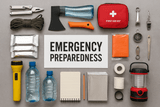Building Your Own Bug Out Bag
What Is A Bug Out Bag?
A bug out bag is a long-term survival kit with one core purpose—to get you away from danger as fast and as safely as possible. Other names for it include: get out of dodge bag (GOOD Bag), I’m never coming home bag (INCH Bag), 72-hour kit, go bag, bail-out bag, SHTF bag, personal emergency relocation kit (PERK BAG), and many more.
1. Keep it “Gray”
The gray man theory is simple—you need to blend into your environment as much as possible. Bugging out of a major city with a huge camouflage backpack is the same as putting a giant target on your back.
2. Keep it Modular
Staying organized is key to surviving a SHTF event, and the best way to stay organized is by creating a modular bug out bag.
For instance, if you have a bug out vehicle, there may be items you can store in it as they would be of little use without a ride. If you have items you carry every day (an EDC kit), you can create a pouch that connects to your bug out bag to not double up on items and still have your kits ready to go.
3. Comfortable Weight
The general guideline is that you shouldn’t carry more than 25% of your weight. For example, a 200-lb person shouldn’t carry a bug out bag that weighs more than 50 pounds. Therefore, unless you’re very fit and/or have trained to carry large packs, you should cap the weight at 20% of your body weight, not to exceed 50 pounds.
4. Strength in Numbers
The more people you roll with, the less chance someone will try to rob you. Having bug out buddies also lets you carry more gear. You really don’t need more than one water filter, tent, or trench shovel in your bug out bag. Disperse such items among your crew to collectively have all the bases covered without adding weight.
5. Bug Out Location
Bugging out is all about evacuating a dangerous area to a safe area, right?
If the SHTF is in your local area, make sure you have somewhere to go. It doesn’t have to be a cabin in the middle of nowhere, but your bug out location should be far enough from the danger zone for the short-term.
If the emergency stops the supply chain altogether, you must consider moving to a secluded bug out location. The average Joes of this world will begin evacuating major metropolitan areas, moving into the suburbs, and looking for food and supplies on the way. This is also when your average Joe becomes an alpha predator, so it’s best to avoid him.
Keep in mind, the further you must travel to get to your safe-house, the more food and water you’ll need.
6. Your Environment
The type of gear you’ll need in your bug out bag for evacuating an urban area is different than if you already live in a rural area.
7. Your Health
Don’t forget to include things like prescription medications, glasses and contacts, and any other specific healthcare needs in your bug out bag.
8. Hone Your Skills
The more experienced you are, the less stuff you need.
9. Quality, not Quantity
A bug out bag is an addition to your life insurance policy. However, life insurance pays out when you die—the bug out bag is intended to keep you alive.
When it comes to potentially life-saving items, you don’t want to buy junk. Do your research and buy the best bug out bag gear you can afford.Even if that means buying a secondhand item in good condition. It’s better to have quality used items than a bunch of new, lower-quality items that won’t last nearly as long.
12th Jul 2023
Recent Posts
-
Civil Safety Renews Business Membership with the Canadian Coalition for Firearm Rights (CCFR)
At Civil Safety, our mission is clear: to empower Canadians to take personal responsibility for thei …20th Nov 2025 -
Prepare Today, Thrive Tomorrow: Why Every Canadian Needs a Reliable Emergency Kit
As Canadians, we’re no strangers to unpredictable weather, remote adventures, and the occasional eme …5th Sep 2025 -
Building Your Ultimate Emergency Preparedness Kit: A Step-by-Step Guide for Canadians
In Canada, being prepared for the unexpected is more than a precaution—it’s a necessity. From harsh …10th Jun 2025




